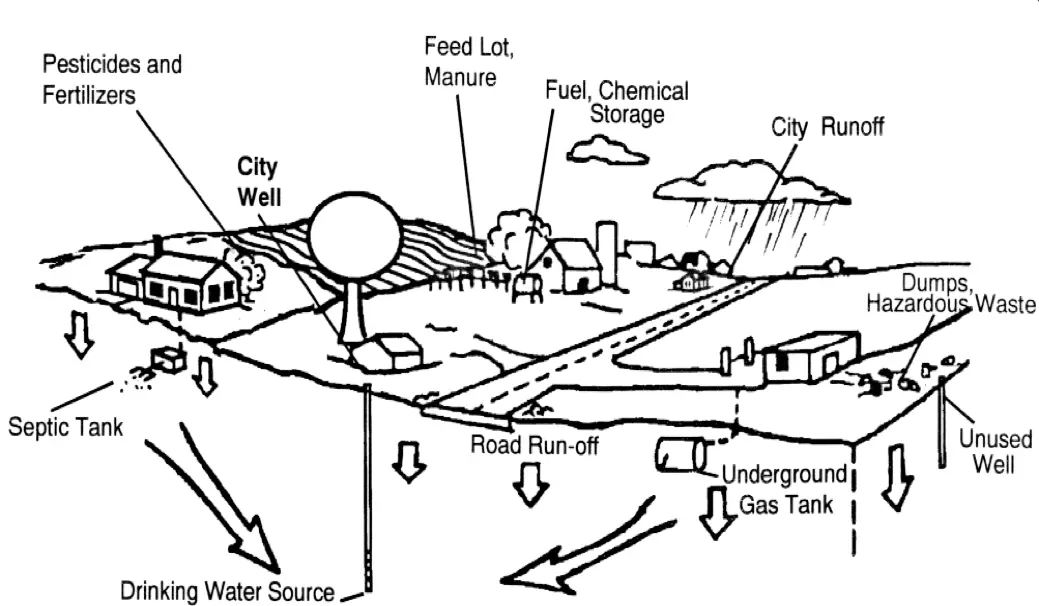What is groundwater?
Groundwater is the water that fills the small spaces between rock particles (sand, gravel, etc.) or cracks in solid rock. Rain, melting snow, or surface water becomes groundwater by seeping into the ground and filling these spaces. The top of the water-saturated zone is called the “water table.”
When water seeps in from the surface and reaches this water table, it begins moving towards points where it can escape, such as wells, rivers, or lakes.
An aquifer is any type of geologic materials, such as sand or sandstone, which can supply water to wells or springs.
The groundwater, which supplies wells, often comes from within a short distance (a few miles) of the well. How fast groundwater moves depends on how much the well is pumped and what type of rock particles or bedrock it is moving through.
A community effort to protect public wells/wellheads
The residents of Owensboro, Kentucky rely on groundwater for their drinking water supply. OMU has more than 30 wells along the East 4th Street/State Route 144 corridor that draw this source water from the Ohio River Alluvium Aquifer. These wells are 100-150 feet deep and protected by a clay layer. The quality of the water coming from these wells is excellent!
Wellhead Protection is a way to prevent drinking water from being polluted by managing possible sources of contamination in the area which supplies water to a public well.
Why do wells sometimes become polluted?

Wells become polluted when substances that are harmful to human health get into the groundwater. Water from these wells can be dangerous to drink when the level of pollution rises above health standards. Many of our everyday activities can cause pollution. Much can be done to prevent pollution, such as wise use of land and chemicals. The expense of treating polluted water or drilling new wells can also be avoided.
Help avoid drinking water contamination by being an environmentally aware citizen.
Wellhead protection will be an ongoing need for our community. Everyone has an important part to play in protecting drinking water wells – today and in the future!
What you can do
- Learn about groundwater and your water source.
- Recycle used motor oil. If not properly handled, used motor oil can get into the ground water supply, causing serious contamination problems.
- Recycle used antifreeze. Antifreeze is toxic to people and animals. It can easily contaminate water. Never pour antifreeze into the environment.
- Recycle leftover hazardous products. Never pour chemicals onto the ground or into storm drains, because they can contaminate the water supply.
- Limit your use of chemicals, fertilizers, pesticides, and other hazardous products. Always follow the label instructions. Use the least toxic product or method available for law, garden, and household pests and weed control.
- If you have a septic system, make sure it is inspected and serviced every three years. Avoid pouring down the drain or toilet products that will harm your septic system such as diapers, coffee grounds, or hazardous chemicals.
- Plug abandoned wells on your property. These old wells provide a direct channel for surface contaminants to reach ground water supplies without being filtered by the soil.
Where you can get more information
- Kentucky Energy and Environment Cabinet, Division of Water can provide information on Kentucky’s Wellhead Protection Program and Groundwater Protection. Call the Division of Water at (502) 564-3410.
- Environmental Protection Agency, Office of Groundwater and Drinking Water, can provide information and resources on groundwater and groundwater protection. Information is available at epa.gov/safewater.
- The Groundwater Foundation can provide motivational and inspirational education and community-based action programs that creatively involve individuals, communities, public and private entities in groundwater conversation and protection.
Wellhead Protection Area
This Wellhead Protection Area is located on the northeastern end of Owensboro, Kentucky. This area contains more than 30 drinking water wells that currently supply drinking water to Daviess, Hancock, Ohio, McLean and Henderson Counties.
Printable Flyer
We offer a print-friendly flyer so that you can share this information with family, friends, and neighbors to help keep our community’s drinking water safe.
